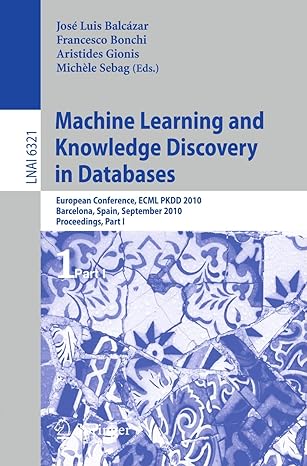Question
Consider the following document collection D = {D1, D2, D3} (given as one document per line): D1 => Silly Sally Sleepy Sally D2 => Seven
Consider the following document collection D = {D1, D2, D3} (given as one document per line):
D1 => Silly Sally Sleepy Sally
D2 => Seven Silly Sheep
D3 => Silly Sheep Should Sleep Silly
Assume that the stopword list contains the word Should, and words are stemmed (that is, converted to their root).
Show the dictionary and the postings list including all the relevant statistics computed, such as raw tf-idf values shown explicitly as (tf,idf) with each document in the postings list), for implementing (uncompressed) inverted index structure for Vector Space Ranked Retrieval in an easy-to-read format. Assume that raw term frequency factor is the count of the number of term occurrences in a document (rather than the normalized, log-dampened value) and the inverse document frequency factor is the reciprocal of the fraction of documents that contain the term (rather than its logarithm).
What are the relevance scores and the ranking of the documents for the query: Silly?
Does the ranking change if we define term frequency factor as the normalized fraction of the term occurrences in a document (rather than the raw count).
question : 2
This exercise is based on the course assignment. Consider the following document collection D = {D1, D2, D3} (given as one document per line): Asterix: Asterix the Gaul Asterix and the Golden Sickle Asterix and Cleopatra Assume that the stopword list contains the word the, and words are not stemmed. For the given example, show the dictionary and the postings list including all the relevant statistics computed (such as tf-idf values shown explcitly as (tf,idf) with each document in the postings list) for implementing (uncompressed) inverted index structure for Vector Space Ranked Retrieval in an easy-to-read format. Assume that term frequency factor is the count of the number of term occurrences in a document (rather than the normalized value) and the inverse document frequency factor is the reciprocal of the fraction of documents that contain the term (rather than its logarithm). What are the relevance scores and the relative ranking of the documents for the query Asterix? Does the ranking change if we were to define term frequency factor as the normalized fraction of the term occurrences in a document (rather than the raw count).
Hii, this was my third time posting this question. Can you please briefly explain about every step in detail? Mainly i want to know about ranking and relevance score? what formula and how to apply it.. It's my request and can u mention mail so that i can contact you if any doubt.. If not just solve this in detail
Step by Step Solution
There are 3 Steps involved in it
Step: 1

Get Instant Access to Expert-Tailored Solutions
See step-by-step solutions with expert insights and AI powered tools for academic success
Step: 2

Step: 3

Ace Your Homework with AI
Get the answers you need in no time with our AI-driven, step-by-step assistance
Get Started


